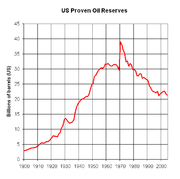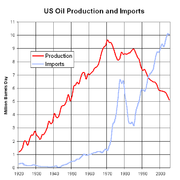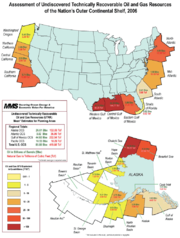
Oil reserves in the United States
Encyclopedia

United States
The United States of America is a federal constitutional republic comprising fifty states and a federal district...
are 21 Goilbbl, excluding the Strategic Petroleum Reserve
Strategic Petroleum Reserve
The Strategic Petroleum Reserve is an emergency fuel storage of oil maintained by the United States Department of Energy.- United States :The US SPR is the largest emergency supply in the world with the current capacity to hold up to ....
. The U.S. Department of the Interior estimates the total volume of undiscovered, technically recoverable prospective resources in all areas of the United States, including the Federal Outer Continental Shelf
Outer Continental Shelf
The Outer Continental Shelf is a peculiarity of the political geography of the United States and is the part of the internationally recognized continental shelf of the United States which does not fall under the jurisdictions of the individual U.S...
, the 1002 area of the Arctic National Wildlife Refuge
Arctic Refuge drilling controversy
The question of whether to drill for oil in the Arctic National Wildlife Reserve has been an ongoing political controversy in the United States since 1997...
, the National Petroleum Reserve–Alaska
National Petroleum Reserve–Alaska
The National Petroleum Reserve in Alaska is an area of land on the Alaska North Slope owned by the United States federal government and managed by the Department of the Interior, Bureau of Land Management . It lies to the west of the Arctic National Wildlife Refuge, which as a U.S...
, and the Bakken Formation
Bakken Formation
The Bakken formation, initially described by geologist J.W. Nordquist in 1953,is a rock unit from the Late Devonian to Early Mississippian age occupying about of the subsurface of the Williston Basin, underlying parts of Montana, North Dakota, and Saskatchewan...
, total 134 Goilbbl of crude oil
Petroleum
Petroleum or crude oil is a naturally occurring, flammable liquid consisting of a complex mixture of hydrocarbons of various molecular weights and other liquid organic compounds, that are found in geologic formations beneath the Earth's surface. Petroleum is recovered mostly through oil drilling...
. This excludes oil shale reserves
Oil shale reserves
Oil shale reserves refers to oil shale resources that are recoverable under given economic restraints and technological abilities. Oil shale deposits range from small presently non-economic occurrences to large presently commercially exploitable reserves...
, as there is no significant commercial production of oil from oil shale
Oil shale
Oil shale, an organic-rich fine-grained sedimentary rock, contains significant amounts of kerogen from which liquid hydrocarbons called shale oil can be produced...
in the United States.
Proven reserves

United States
The United States of America is a federal constitutional republic comprising fifty states and a federal district...
proven oil reserves were 21 Goilbbl in 2006 according to the Energy Information Administration
Energy Information Administration
The U.S. Energy Information Administration is the statistical and analytical agency within the U.S. Department of Energy. EIA collects, analyzes, and disseminates independent and impartial energy information to promote sound policymaking, efficient markets, and public understanding of energy and...
. This represents a decline of 46%, or 18 Goilbbl from 39 Goilbbl in 1970. U.S. crude production peaked in 1970 at 9.6 Moilbbl/d, after the supergiant Prudhoe Bay field was found in Alaska. It has declined 47% to 5.1 Moilbbl/d by 2006. United States crude oil production has been declining since reaching a smaller secondary production peak in 1988 (caused by Alaskan production). Total production of crude oil from 1970 through 2006 was 102 Goilbbl, or roughly five and a half times the decline in proved reserves.
The reserves-to-production ratio
Reserves-to-production ratio
The Reserves-to-production ratio is the remaining amount of a non-renewable resource, expressed in years. While applicable to all natural resources, the RPR is most commonly applied to fossil fuels, particularly petroleum and natural gas...
(R/P) equaled 11.26 years in 2007. The ratio was 11.08 years in 1970. It hit a trough of 8.49 years in 1986 as oil pumped through the Alaska pipeline began to peak.
Because of declining production and increasing demand, Net US imports of oil and petroleum product
Petroleum product
Petroleum products are useful materials derived from crude oil as it is processed in oil refineries.According to crude oil composition and demand, refineries can produce different shares of petroleum products. The largest share of oil products is used as energy carriers: various grades of fuel...
s increased by 400% from 3.16 Moilbbl/d in 1970 to 12.04 Moilbbl/d in 2007. Its largest net suppliers of petroleum products in 2007 were Canada and Mexico, which supplied 2.2 Moilbbl/d, respectively.
Net imports of oil and products account for nearly half of the US trade deficit. As of 2007, the US consumed 20.68m bbls of petroleum products/day and imported a net 12.04m bbls/day. The EIA reports the United States "Dependence on Net Petroleum Imports" as 58.2%.
Strategic Petroleum Reserve
The United States maintains a Strategic Petroleum ReserveStrategic Petroleum Reserve
The Strategic Petroleum Reserve is an emergency fuel storage of oil maintained by the United States Department of Energy.- United States :The US SPR is the largest emergency supply in the world with the current capacity to hold up to ....
at four sites in the Gulf of Mexico
Gulf of Mexico
The Gulf of Mexico is a partially landlocked ocean basin largely surrounded by the North American continent and the island of Cuba. It is bounded on the northeast, north and northwest by the Gulf Coast of the United States, on the southwest and south by Mexico, and on the southeast by Cuba. In...
, with a total capacity of 727 Moilbbl of crude oil. The maximum total withdrawal capability from the United States Strategic Petroleum Reserve is 4.4 Moilbbl per day. This is roughly 32% of US oil imports, or 75% of imports from OPEC.


Prospective resources
Services under the U.S. Department of the Interior estimate the total volume of undiscovered, technically recoverable oil in the United States to be roughly 134 Goilbbl. Over 1 million exploratory and developmental crude oil wells have already been drilled in the US since 1949.The Minerals Management Service
Minerals Management Service
The Bureau of Ocean Energy Management, Regulation and Enforcement , formerly known as the Minerals Management Service , was an agency of the United States Department of the Interior that managed the nation's natural gas, oil and other mineral resources on the outer continental shelf...
(MMS) estimates the Federal Outer Continental Shelf
Outer Continental Shelf
The Outer Continental Shelf is a peculiarity of the political geography of the United States and is the part of the internationally recognized continental shelf of the United States which does not fall under the jurisdictions of the individual U.S...
(OCS) contains between 66.6 Goilbbl of undiscovered technically recoverable crude oil, with a mean estimate of 85.9 Goilbbl. The Gulf of Mexico OCS ranks first with a mean estimate of 44.9 Goilbbl, followed by Alaska OCS with 38.8 Goilbbl. At $80/bbl crude prices, the MMS estimates that 70 Goilbbl are economically recoverable. As of 2008, a total of about 574 million acres (2,322,897.6 km²) of the OCS are off-limits to leasing and development. The moratoria and presidential withdrawal cover about 85 percent of OCS area offshore the lower 48 states. The MMS estimates that the resources in OCS areas currently off limits to leasing and development total 17.8 Goilbbl(mean estimate).
The United States Geological Survey
United States Geological Survey
The United States Geological Survey is a scientific agency of the United States government. The scientists of the USGS study the landscape of the United States, its natural resources, and the natural hazards that threaten it. The organization has four major science disciplines, concerning biology,...
(USGS) estimates undiscovered technically recoverable crude oil onshore in United States to be 48.5 Goilbbl
The last comprehensive National Assessment was completed in 1995. Since 2000 the USGS has been re-assessing basins of the U.S. that are considered to be priorities for oil and gas resources. Since 2000, the USGS has re-assessed 22 priority basins, and has plans to re-assess 10 more basins. These 32 basins represent about 97% of the discovered and undiscovered oil and gas resources of the United States. The three areas considered to hold the most amount of oil are the coastal plain (1002) area of ANWR, the National Petroleum Reserve of Alaska, and the Bakken Formation.
In 1998, the USGS estimated that 1002 area of the Arctic National Wildlife Refuge
Arctic National Wildlife Refuge
The Arctic National Wildlife Refuge is a national wildlife refuge in northeastern Alaska, United States. It consists of in the Alaska North Slope region. It is the largest National Wildlife Refuge in the country, slightly larger than the Yukon Delta National Wildlife Refuge...
contains a total of between 5.7 and 16 Goilbbl of undiscovered, technically recoverable oil, with a mean estimate of 10.4 Goilbbl, of which 7.7 Goilbbl falls within the Federal portion of the ANWR 1002 Area. In May 2008 the EIA used this assessment to estimate the potential cumulative production of the 1002 area of ANWR to be a maximum of 4.3 Goilbbl from 2018 to 2030. This estimate is a best case scenario of technically recoverable oil during the area's primary production years if legislation were passed in 2008 to allow drilling.
A 2002 assessment concluded that the National Petroleum Reserve–Alaska
National Petroleum Reserve–Alaska
The National Petroleum Reserve in Alaska is an area of land on the Alaska North Slope owned by the United States federal government and managed by the Department of the Interior, Bureau of Land Management . It lies to the west of the Arctic National Wildlife Refuge, which as a U.S...
contains between 6.7 and 15 Goilbbl of oil, with a mean (expected) value of 10.6 Goilbbl. The quantity of undiscovered oil beneath Federal lands (excluding State and Native areas) is estimated to range between 5.9 and 13.2 BBO, with a mean value of 9.3 BBO. Most oil accumulations are expected to be of moderate size, on the order of 30 to 250 Moilbbl each. Large accumulations like the Prudhoe Bay oil field
Prudhoe Bay oil field
Prudhoe Bay Oil Field is a large oil field on Alaska's North Slope. It is the largest oil field in both the United States and in North America, covering and originally containing approximately of oil.. BP. August 2006...
(whose ultimate recovery is approximately 13 Goilbbl), are not expected to occur. The volumes of undiscovered, technically recoverable oil estimated for NPRA are similar to the volumes estimated for ANWR. However, because of differences in accumulation sizes (the ANWR study area is estimated to contain more accumulations in larger size classes) and differences in assessment area (the NPRA study area is more than 12 times larger than the ANWR study area), economically recoverable resources are different at low oil prices. But at market prices above $40 per barrel, estimates of economically recoverable oil for NPRA are similar to ANWR.
In April 2008, the USGS released a report giving a new resource assessment of the Bakken Formation
Bakken Formation
The Bakken formation, initially described by geologist J.W. Nordquist in 1953,is a rock unit from the Late Devonian to Early Mississippian age occupying about of the subsurface of the Williston Basin, underlying parts of Montana, North Dakota, and Saskatchewan...
underlying portions of Montana and North Dakota. The USGS believes that with new horizontal drilling
Directional drilling
Directional drilling is the practice of drilling non-vertical wells. It can be broken down into three main groups: Oilfield Directional Drilling, Utility Installation Directional Drilling Directional drilling (or slant drilling) is the practice of drilling non-vertical wells. It can be broken down...
technology there is somewhere between 3 Goilbbl of undiscovered, technically recoverable oil in this 200000 square miles (517,997.6 km²) formation that was initially discovered in 1951. If accurate, this reassessment would make it the largest "continuous" oil accumulation (The USGS uses "continuous" to describe accumulations requiring extensive artificial fracturing to allow the oil to flow to the borehole) ever discovered in the U.S. The formation is estimated to contain significantly more - figures in excess of 150 Goilbbl have been reported - but it is yet uncertain how much of this oil is recoverable using current technology. In 2011, Harold Hamm
Harold Hamm
Harold Hamm is an American oilman who was ranked in the March 2011 issue of Forbes as the 33rd richest person in America, with a net worth of $8.6 billion. Hamm is a key player in Hiland Partners and Hiland Holdings as well as the oil-exploration company Continental Resources, Oklahoma's fourth...
claimed that the recoverable share may reach 24 Goilbbl; this would mean that Bakken contains more extractable petroleum than all other known oil fields in the country, combined.
Oil shale
The United States has the largest known deposits of oil shaleOil shale
Oil shale, an organic-rich fine-grained sedimentary rock, contains significant amounts of kerogen from which liquid hydrocarbons called shale oil can be produced...
in the world, according to the Bureau of Land Management
Bureau of Land Management
The Bureau of Land Management is an agency within the United States Department of the Interior which administers America's public lands, totaling approximately , or one-eighth of the landmass of the country. The BLM also manages of subsurface mineral estate underlying federal, state and private...
and holds an estimated 2.175 Toilbbl of potentially recoverable oil. Oil shale does not actually contain oil, but a waxy oil precursor known as kerogen
Kerogen
Kerogen is a mixture of organic chemical compounds that make up a portion of the organic matter in sedimentary rocks. It is insoluble in normal organic solvents because of the huge molecular weight of its component compounds. The soluble portion is known as bitumen. When heated to the right...
. There is no significant commercial production of oil from oil shale in the United States.

